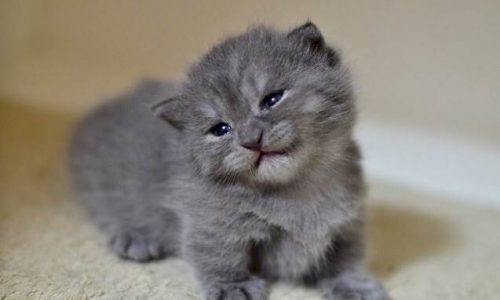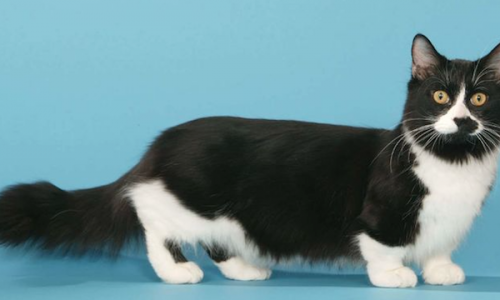Munchkin cats as a breed have generated their fair share of controversy. Raising kittens is a very special experience, as any cat lover probably knows. What if your cat could stay the size of a tiny kitten forever? What if you could hold your full grown cat in one hand? For owners of the rare, but up-and-coming Munchkin cat, this dream is reality.
Watch the video to discover more about the Munchkin breed of cats and see more details below.
20 Interesting Munchkin Cat Facts
Discover more information about this super cute breed below.
Munchkin Cat Photos
The fun-sized cats are on average 4 to 8 inches tall, and have extremely short legs, but long bodies. Their body shape is comparable to dachshunds and basset hounds. In fact, they have almost identical genetic mutations that cause their compact body shape. Fear not, because unlike the hound dogs, they do not typically have back problems later in life.
These cats are fun-loving, energetic and outgoing. They are great for children or other cats, because they are comfortable with socialization and love to play. Because of their short stature, the cats have very good lateral agility, although they are vertically challenged. Their movement can be compared to that of a ferret.
Interesting Facts about Munchkin Cats
Short Legs are Genetic – Munchkin cats are known for their short legs, which are the result of a naturally occurring genetic mutation called achondroplasia. This mutation affects the length of their limbs, giving them their distinct appearance.
2. Name Origin – The breed was named “Munchkin” after the tiny people in L. Frank Baum’s book The Wonderful Wizard of Oz because of their small stature.
3. Not a New Breed – Although they gained recognition in the 1990s, the genetic mutation responsible for Munchkin cats has been documented as early as the 1940s. However, many early examples were lost due to World War II.
4. A Wide Variety of Colors and Patterns – Munchkin cats can come in a wide variety of colors and patterns, including solid, tabby, tuxedo, calico, and more. Their coat length can also vary, ranging from short-haired to long-haired.
5. Highly Playful and Energetic – Despite their short legs, Munchkin cats are very playful and energetic. They enjoy playing fetch and can be very fast runners, surprising many with their agility.
6. Low Jumps but Still Agile – Munchkins aren’t great at jumping as high as other cat breeds due to their shorter legs, but they still find creative ways to climb, often jumping to lower surfaces first to reach higher areas.
7. Friendly and Social – Munchkin cats are known for their friendly and affectionate personalities. They tend to enjoy being around humans and often get along well with children and other pets, including dogs.
8. “Ferret-like” Running Style – The way Munchkin cats run is often compared to a ferret. Their short legs make their gait a little different, adding to their unique charm.
9. Officially Recognized Breed – The Munchkin breed was officially recognized by The International Cat Association (TICA) in 1995, but it has not yet been recognized by other associations like the Cat Fanciers’ Association (CFA), primarily due to ethical debates over the short-legged mutation.
10. Health Considerations – Munchkin cats are relatively healthy, and the gene responsible for their short legs does not necessarily lead to major health issues. However, some believe that they may be predisposed to spinal issues similar to dogs with short legs, like Dachshunds.
11. Natural Hunters – Munchkins retain their natural hunting instincts, and they’re known for being excellent at catching small prey. They’re adept at “stalking” and “pouncing,” despite their limitations in jumping height.
12. Curious and Smart – They’re curious cats who love to explore their environment. Their curiosity is often paired with intelligence, making them quick learners when it comes to playing interactive games.
13. “Magpie” Tendencies – Some Munchkin cats exhibit “magpie” tendencies, which means they like to hoard small objects and stash them in a particular spot. This trait makes them endearing to owners who may find a collection of toys and trinkets hidden away!
14. Not Dwarfs – Although they have short legs, Munchkin cats are not considered “dwarfs” because their heads, bodies, and tails are proportionate to each other—only their legs are shortened.
15. They Often Sit Like Meerkats – Munchkins have an adorable tendency to sit up on their hind legs like a meerkat or rabbit, using their back paws to balance. This posture makes them appear even more endearing to many people.
16. Affectionate Lap Cats – Many Munchkins are considered lap cats and enjoy cuddling with their owners. They are typically affectionate without being overly demanding, making them wonderful companion pets.
17. Long-Lived Companions – Munchkin cats generally have a long lifespan, similar to that of other domestic cats, ranging from 12 to 15 years, provided they receive proper care and regular veterinary checkups.
18. Controversial Breed Development – Munchkin cats have been subject to ethical debates among cat enthusiasts. Some argue that breeding cats specifically for short legs may result in health problems, while others support their breeding as long as it’s done ethically.
19. Good Apartment Cats – Because of their size and moderate energy levels, Munchkin cats are well-suited for apartment living. They don’t need large open spaces but do appreciate having plenty of vertical space and cozy spots to explore.
20. They Have Different Generations – Munchkin kittens can vary in leg length, even within the same litter. There are “standard” Munchkins, which have the characteristic short legs, and “non-standard” ones, which have regular-length legs.
21. Adaptable to Different Environments – Munchkin cats are quite adaptable and can do well in various environments, whether it’s a busy family home or a quieter space with a single person. They typically adjust well to their owner’s lifestyle.
22. Love to Burrow – Munchkin cats enjoy burrowing into blankets or pillows, often making a cozy nest to curl up in. This habit is likely linked to their love for comfort and their somewhat “dwarfed” size.
23. Prone to Obesity – Like many domestic cats, Munchkins can be prone to obesity if they are overfed and under-exercised. Maintaining an active lifestyle with plenty of playtime helps keep them healthy and fit.
24. Their Short Legs Don’t Mean Short Playtimes – Munchkin cats don’t let their short legs slow them down during playtime! They are known to chase toys and run around as energetically as any other breed, often surprising owners with their speed.
25. Breeding Requirements – When breeding Munchkins, only one parent should carry the short-legged gene. If both parents carry it, it can result in serious health complications for the kittens. This is why ethical breeding is essential to the breed’s health and welfare.
26. Variety of Tail Types – Their tails can also vary in length and fluffiness depending on the individual cat, adding to the wide variety of appearances Munchkin cats can have.
27. Popular but Controversial Online – Due to their unique look, Munchkins have gained popularity on social media platforms. Their adorable appearance makes them internet sensations, even though the ethical considerations surrounding the breed continue to provoke debate among cat lovers.
We suggest adopting your Munchkin from a highly experienced breeder who knows what they’re doing. When the cats are properly bred, they are an excellent addition to any cat lover’s family. Munchkins come in all colors; no two coats are alike. The cats either have short fur or long, silky coats. They are low maintenance cats, as they only require routine checkups and one or two brushings a week.
Remember to “share” this with other fans of the Munchkin breed of cats!








